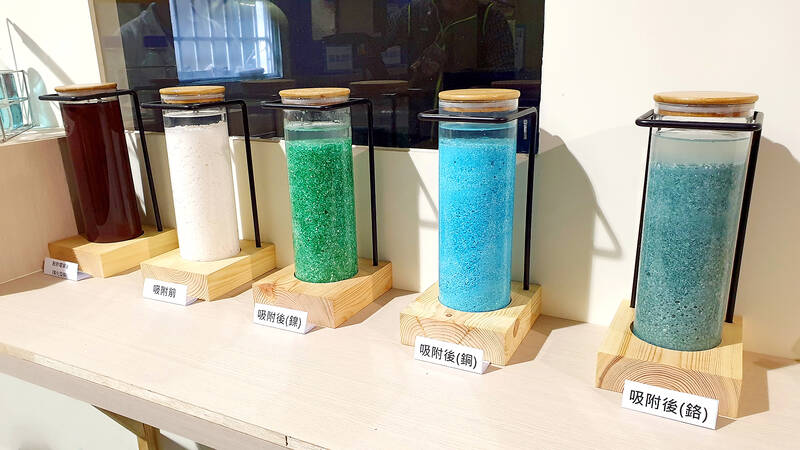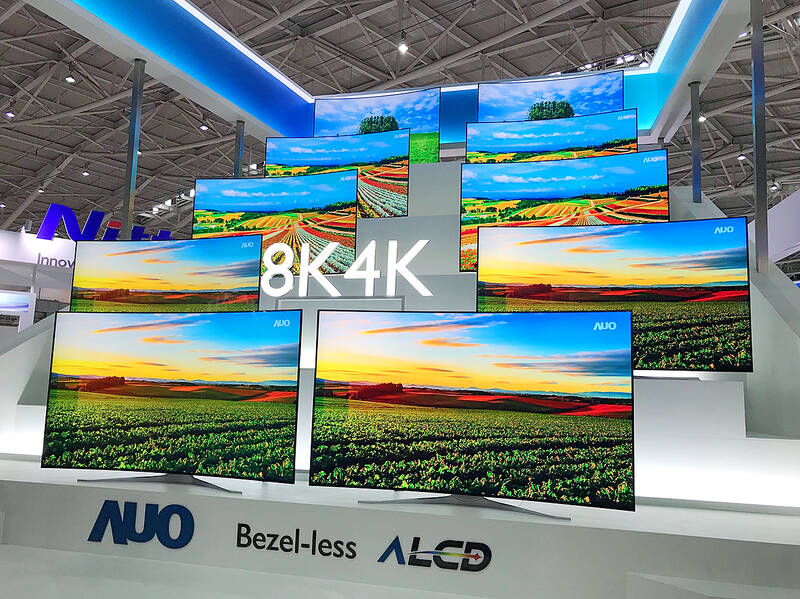Liquid crystal displays (LCDs) are ubiquitous. In addition to being a crucial part of every smartphone, laptop and television, they appear on vending machines and thermostat controllers, and inside cars, buses and trains.
Compared to the cathode-ray tube (CRT) displays which they’ve almost entirely replaced over the past 15 years, LCDs are significantly more durable. But at some point they break or burn out — or the device they’re in no longer works — and they have to be sent for disposal.
Taiwan is one of the world’s top four producers of LCDs, and across the country around 8,000 metric tons of LCD panels are junked each year. The majority of these waste panels never reach the consumer, instead being discarded by manufacturers after defects are discovered.

Photo courtesy of EPA
That might seem like a drop in the ocean compared to the 11.85 million metric tons of general waste that Taiwan generated last year. But in a country that already faces a gamut of environmental challenges, it’s imperative to find a good solution for every type of waste.
For a long time, unwanted LCD panels in Taiwan were dealt with in one of three ways. Some were dumped in landfills, where there’s a risk they’ll release toxins such as lead and mercury into soil and water. Some were incinerated, further sullying Taiwan’s already polluted air. The majority of LCDs made before 2009 used cold cathode fluorescent lamps for backlighting, rather than the current LED technology. Due to their composition, those old LCDs are especially dangerous if incinerated.
Others were ground into a powder that’s mainly glass and which can be added to concrete. Glass-based powders enhance the workability of concrete before it sets, thus saving energy and time. And once it’s hardened, concrete containing such powder demonstrates improved strength. Yet turning a sophisticated product into a bulk commodity isn’t recycling, but downcycling.

Photo: Chen Mei-ying, Taipei Times
NEW SOLUTIONS
Scientists at Taiwan’s Industrial Technology Research Institute (ITRI) have devised a solution they claim is much better than landfilling, incineration or grinding.
According to e-mailed answers provided by ITRI — a state-run R&D body — the institute’s LCD recycling system comprises “a six-step process of separation, extraction, purification, scrubbing, concentration and modification.” It begins with separating the liquid crystals (typically 0.12 to 0.14 percent by weight), indium (about 0.02 percent) and glass (over 80 percent) within each panel.

Photo: Liu Hsiao-hsin, Taipei Times
After processing and purification, those three materials can be reused.
LCD panels also include thin-film transistors (TFTs), which contain silicon and certain metals, such as molybdenum, tantalum, copper and titanium. But, as the ITRI team explains, because TFTs account for a mere 0.001 percent of each panel by weight, the quantity of retrievable materials is too small to justify separation and recovery.
Each LCD panel is a multi-layered “sandwich” that also includes polarizer, sealant and color filters. The panels are folded to expose the liquid crystals, then first dipped in an organic solvent to extract the crystals.
Recycled liquid crystals can be used to make new LCD panels or to manufacture smart glass. The latter is a type of glass that changes its reflective properties to stop excessive sunshine from entering a building, to reduce the amount of energy required to keep the interior cool.
Extracting indium is more difficult. Previously-discovered methods have proved unattractive due to high cost, even when scaled up. ITRI discovered that first removing the liquid crystals makes it easier to recover the indium without using strong acids. What’s more, says ITRI, “our leaching agents are reusable, and this reduces wastewater.” (As explained in “Getting to grips with Taiwan’s e-waste” in the June 14 edition of the Taipei Times, a major problem with traditional hydrometallurgical treatment of electronic waste is that it usually creates toxic effluent.)
As well as producing a precipitate that’s partially indium powder, the stripping solution removes the polarizers, which float on top of the stripping solution, making their collection easy.
Glass from panels is ground into particles about 3mm in size. After a modifying agent has been added, the mixture is melted at a high temperature to form a nano-porous glass adsorbent. According to ITRI, this novel material can be used for “high efficiency treatment of wastewater containing heavy metals” and that “chemical analysis shows it is non-toxic and eco-friendly.”
Any industry that produces wastewater containing heavy metals — including makers of LCDs, LEDs and PCBs, and the semiconductor and electroplating sectors — “could greatly benefit from applying our adsorbent,” the ITRI team says. It could also have applications for waste lead-acid battery treatment plants and remediation of contaminated soils.
ITRI designed a wastewater treatment system for electroplating companies based in Changbin Industrial Park (彰濱工業區) in Changhua County.
“The treated water circles back to the factories for reuse, and the adsorbed and removed metal ions are desorbed and concentrated for further recycling,” ITRI says.
Since the facility was inaugurated in early 2021, the water-treatment system has been upgraded, and several more industry partners have joined the project.
PRIVATE SECTOR INTEREST
ITRI’s panel-recycling efforts received financial support from the Ministry of Economic Affairs and the Environmental Protection Administration, and there’s been some interest from the private sector.
ITRI has licensed elements of its LCD recycling system to InnoLux Corp, a major panel maker headquartered in Miaoli, and to Fortune WEEE Solution Inc in the US. In 2019, ITRI helped both companies set up liquid crystal separation systems.
On Jan. 17 this year, the Chinese-language United Daily News reported that InnoLux had recently added zero-pollution automated processes to their handling of waste LCD panels. The newspaper quoted one of the company’s managers as saying that, between 2019 and last year, Innolux processed 3,445 metric tons of waste glass and extracted 1.7 metric tons of liquid crystals.
During the same period, the report noted, the company used recycled liquid crystal to manufacture the equivalent of 920,000 42-inch TVs, “with excellent results.” Compared to making LCD panels using brand-new materials, recycling 1,000 metric tons of panels reduces the company’s carbon footprint by 507.2 metric tons, the newspaper reported.
Waste-panel recycling doesn’t just reduce the amount InnoLux has to spend on materials for new panels. It also saves money by reducing the quantity of waste that has to be sent for external processing and disposal, ITRI points out.
The ITRI recycling process makes financial sense, and both InnoLux and Fortune WEEE are reported to have had positive experiences using it. But, ITRI explains, regulatory challenges are hindering its adoption by other companies.
“Across different regions, there’s significant variation and ambiguity in the definitions and regulations concerning modern electronics like panels, as well as the appropriate handling and disposal of the chemical waste they generate,” says the ITRI team. This lack of consistency creates hurdles for waste processors trying to quickly generate revenue, as substantial time and effort must be invested to adapt to local circumstances.
As the saga of recycling in Taiwan shows, crafting domestic rules so innovators can put their best ideas into practice here is difficult enough. When it comes to other jurisdictions, researchers can’t do much except offer proof of concept, and hope.
Steven Crook, the author or co-author of four books about Taiwan, has been following environmental issues since he arrived in the country in 1991. He drives a hybrid and carries his own chopsticks. The views expressed here are his own.

As I finally slid into the warm embrace of the hot, clifftop pool, it was a serene moment of reflection. The sound of the river reflected off the cave walls, the white of our camping lights reflected off the dark, shimmering surface of the water, and I reflected on how fortunate I was to be here. After all, the beautiful walk through narrow canyons that had brought us here had been inaccessible for five years — and will be again soon. The day had started at the Huisun Forest Area (惠蓀林場), at the end of Nantou County Route 80, north and east

A six-episode, behind-the-scenes Disney+ docuseries about Taylor Swift’s Eras Tour and Rian Johnson’s third Knives Out movie, Wake Up Dead Man, are some of the new television, films, music and games headed to a device near you. Also among the streaming offerings worth your time this week: Chip and Joanna Gaines take on a big job revamping a small home in the mountains of Colorado, video gamers can skateboard through hell in Sam Eng’s Skate Story and Rob Reiner gets the band back together for Spinal Tap II: The End Continues. MOVIES ■ Rian Johnson’s third Knives Out movie, Wake Up Dead Man

Specialty sandwiches loaded with the contents of an entire charcuterie board, overflowing with sauces, creams and all manner of creative add-ons, is perhaps one of the biggest global food trends of this year. From London to New York, lines form down the block for mortadella, burrata, pistachio and more stuffed between slices of fresh sourdough, rye or focaccia. To try the trend in Taipei, Munchies Mafia is for sure the spot — could this be the best sandwich in town? Carlos from Spain and Sergio from Mexico opened this spot just seven months ago. The two met working in the

Politics throughout most of the world are viewed through a left/right lens. People from outside Taiwan regularly try to understand politics here through that lens, especially those with strong personal identifications with the left or right in their home countries. It is not helpful. It both misleads and distracts. Taiwan’s politics needs to be understood on its own terms. RISE OF THE DEVELOPMENTAL STATE Arguably, both of the main parties originally leaned left-wing. The Chinese Nationalist Party (KMT) brought together radicals, dissidents and revolutionaries devoted to overthrowing their foreign Manchurian Qing overlords to establish a Chinese republic. Their leader, Sun Yat-sen